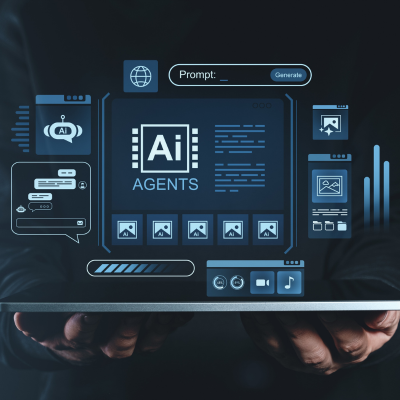Artificial intelligence is transforming cybersecurity, reshaping how organizations detect, prevent, and respond to cyber threats in 2025. Leveraging advanced machine learning security, anomaly detection, and AI-powered digital protection tools—including AI firewalls and adaptive zero-trust frameworks—businesses are defending against increasingly sophisticated attacks like ransomware, phishing, and social engineering. This article provides a detailed exploration of AI in cybersecurity, covering the latest trends, advanced defense tactics, real-world business case studies, and practical guidance for technology leaders and software engineers. It also highlights why the Software Engineering, Agentic AI and Generative AI Course from Amquest Education is the premier program to master these critical AI-powered cyber defense skills.
Introduction: The New Frontier of Cyber Defense with AI
Cybersecurity threats are evolving rapidly, with attackers increasingly using AI themselves to craft more complex and adaptive attacks. In response, defenders are integrating AI-driven approaches that enhance threat detection, reduce false positives, and enable adaptive cyber defense. AI’s ability to analyze vast datasets in real time and identify subtle anomalies is revolutionizing digital protection strategies, making AI indispensable in modern cybersecurity architectures. As ransomware, phishing, and insider threats grow in scale and complexity, AI-powered tools such as machine learning security models and natural language processing (NLP) are essential for safeguarding networks and sensitive data. This article explores the evolution of AI in cybersecurity, its latest applications, and actionable strategies for leveraging these technologies effectively.
Evolution of AI in Cybersecurity: From Rules to Intelligence
Traditional cybersecurity relied heavily on static rule-based systems that detected attacks by matching known signatures. While effective against established threats, these systems struggled with novel or unknown attack vectors and frequently triggered false alarms. The rise of machine learning security marked a paradigm shift. Machine learning models learn from data patterns and detect anomalies without explicit rules, enabling identification of previously unseen threats. These AI models continuously improve by adapting to emerging threats, enhancing early detection and enabling proactive cyber defense. Integration of AI within Security Operations Centers (SOCs) is enabling semi-autonomous workflows, where AI agents assist human analysts by triaging alerts, investigating incidents, and automating response actions. This synergy increases operational efficiency and reduces human error.
Latest Features and Trends: AI-Driven Cyber Defense in 2025
Threat Detection and Anomaly Detection
One of the most impactful uses of AI in cybersecurity is threat detection. AI systems analyze network traffic, user behavior, and system logs in real time to identify deviations from normal patterns signaling malicious activity. Unlike traditional methods, AI detects novel threats by learning subtle signals, reducing false positives and alert fatigue for security teams.
Zero-Trust Security Powered by AI
Modern zero-trust security frameworks have advanced beyond static policies and multifactor authentication (MFA). AI models now incorporate context-aware factors such as device health, geolocation, and user behavior to make dynamic access decisions. Solutions like Cisco’s Duo Trust Monitor and Okta’s Adaptive MFA demonstrate how AI enhances zero-trust frameworks by tightening defenses without compromising user experience.
AI in Red Teaming and Adversarial Testing
AI is revolutionizing security testing. Platforms like Cymulate’s Breach and Attack Simulation use AI to automatically probe networks and simulate real-world attack paths, accelerating vulnerability discovery. Emerging research leveraging large language models (LLMs) for adversarial testing uncovers blind spots human testers might miss, strengthening security posture.
Combating Ransomware and Phishing
Ransomware remains a top threat, but AI effectively detects early ransomware behaviors and orchestrates rapid response. Additionally, AI-powered NLP models analyze email content to detect sophisticated phishing attempts that evade traditional filters by assessing tone, urgency, and sender credibility.
AI-Driven Automation in SOCs
AI agents are increasingly automating routine SOC tasks such as alert triage, compliance checks, and incident investigation. This automation reduces mean time to detect (MTTD) and mean time to respond (MTTR), enabling security teams to focus on complex threats and strategic defense.
Addressing AI Governance and Privacy
With AI’s growing role, organizations must implement governance frameworks to ensure AI models are secure, ethical, and privacy-compliant. Protecting AI data pipelines and models from adversarial attacks and biases is critical for maintaining trust and compliance in cybersecurity.
Advanced Tactics for Success: Leveraging AI in Cyber Defense
- Implement AI-augmented SOCs: Integrate AI agents for alert triage, investigation, and automated remediation to reduce detection and response times.
- Adopt AI-powered zero-trust controls: Use adaptive authentication and continuous monitoring to dynamically manage user access based on risk profiles.
- Utilize AI-driven threat intelligence: Combine internal telemetry with external feeds analyzed by AI to anticipate emerging threats.
- Regularly simulate attacks with AI tools: Employ AI-enabled red teaming and attack simulations to identify vulnerabilities proactively.
- Invest in AI literacy and training: Equip security teams with skills to manage AI tools effectively, including continuous retraining of AI models to adapt to evolving threats.
- Establish AI governance: Develop policies and controls to safeguard AI models and data privacy, ensuring responsible AI use in cybersecurity.
The Power of Content, Storytelling, and Community in Cybersecurity
Building strong cybersecurity communities around AI innovations fosters knowledge sharing and rapid threat response. Storytelling through detailed case studies and threat reports demystifies AI’s role and builds trust in AI-driven defenses. Collaborative platforms connecting security practitioners, researchers, and AI developers accelerate robust cyber defense strategies. Examples of successful communities include open threat intelligence sharing groups and AI-focused cybersecurity forums that drive innovation and collective defense.
Measuring Success: Analytics and Insights from AI in Cybersecurity
AI’s data-driven nature enables organizations to measure cyber defense effectiveness quantitatively. Key performance indicators include:
- Reduction in false positives and alert volumes
- Decreased mean time to detect (MTTD) and mean time to respond (MTTR)
- Improved accuracy in identifying zero-day exploits and insider threats
- Enhanced compliance and risk management metrics
Continuous analytics and feedback loops ensure AI models remain effective against evolving threats.
Business Case Study: How Cisco Enhanced Cyber Defense with AI
Cisco integrated AI-powered tools such as Duo Trust Monitor into its zero-trust framework to dynamically assess user risk and detect anomalous behaviors. This adaptive approach reduced unauthorized access incidents by over 30% within a year. By automating threat detection and response workflows, Cisco’s security operations team improved efficiency, cutting incident response times by 40%. This case highlights how AI integration yields measurable improvements in cyber defense.
Actionable Tips for Cybersecurity Leaders and Engineers
- Start small with AI pilots: Test AI models on specific use cases like anomaly detection or phishing prevention before full-scale deployment.
- Choose AI solutions with explainability: Prefer tools providing clear reasoning behind alerts to build trust and ease investigations.
- Ensure data quality and privacy: AI effectiveness depends on clean, relevant data; implement strong data governance to protect sensitive information.
- Leverage expert training: Enroll teams in advanced courses on AI and cybersecurity, such as the Software Engineering, Agentic AI and Generative AI Course, which offers hands-on learning and industry-aligned modules.
- Partner with industry leaders: Collaborate with AI and cybersecurity vendors and participate in communities to stay ahead of emerging threats.
- Maintain continuous AI model retraining: Regularly update AI models to respond to new threats and reduce model drift.
Why Choose Amquest Education for AI in Cybersecurity Mastery?
Amquest Education, based in Mumbai with national online availability, offers a superior Software Engineering, Agentic AI and Generative AI Course designed for professionals seeking deep expertise in AI-powered cybersecurity. Key differentiators include:
- AI-led modules combining theoretical foundations with practical, hands-on projects.
- A strong focus on agentic AI and generative AI, preparing learners for next-gen cyber defense applications.
- Robust industry connections offering internships and placement opportunities with leading technology firms.
- Experienced faculty with real-world cybersecurity and AI expertise.
- Flexible learning modes accommodating busy professionals across India.
This uniquely integrated curriculum bridges software engineering and AI-driven security, ensuring graduates are ready to architect and deploy next-generation cyber defense solutions.
Conclusion
AI in cybersecurity is essential for defending against next-generation threats in 2025. From advanced threat detection and machine learning security to adaptive zero-trust frameworks and AI-powered ransomware defense, AI technologies are reshaping the cyber defense landscape. Organizations and professionals embracing these innovations will gain a critical competitive advantage. The Software Engineering, Agentic AI and Generative AI Course from Amquest Education offers a comprehensive, industry-aligned learning path with practical exposure and career support. Embrace AI-driven cybersecurity now to safeguard your organization and your career.
FAQs
Q1: How does AI improve threat detection in cybersecurity?
AI analyzes vast data in real time to identify anomalies and patterns signaling potential threats, reducing false positives and enabling early intervention.
Q2: What role does machine learning security play in cyber defense?
Machine learning models adapt to new threats by learning from data, improving detection accuracy and automating routine security tasks.
Q3: How is AI used in zero-trust security frameworks?
AI enables dynamic, context-aware access control by evaluating user behavior, device health, and environmental factors before granting access.
Q4: Can AI help prevent fraud and phishing attacks?
Yes, AI-powered NLP models detect suspicious email content and social engineering tactics, blocking sophisticated phishing attempts.
Q5: What are AI firewalls and how do they work?
AI firewalls use machine learning to monitor network traffic and block malicious activity by recognizing abnormal patterns beyond static rules.
Q6: How can organizations measure the success of AI in cybersecurity?
Success is tracked via reduced false alarms, faster incident response times, and improved threat detection rates using AI analytics.










